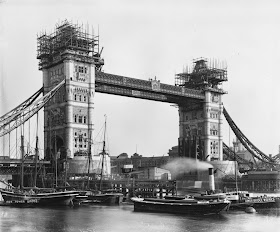Photo above: Opening of the London Bridge.
[By Jonathan @ Londontopia for Londonfiles]
Today marks the day 120 years ago that Tower Bridge was officially opened by the Prince of Wales (not the current one obviously). This special bridge is one that many associate with London. Anyone who sees this Bridge immediately knows that it’s in London (so it’s often the first thing shown in stock footage about London). It’s certainly a beautiful bridge. The Bridge is celebrating its birthday today – it was opened on this day in 1894 by the Prince of Wales, (the future King Edward VII) with much celebration.
So, with much fanfare, here are 10 facts and figures you probably didn’t know about the iconic Bridge.
It's actually not the London Bridge.
It’s a common misconception that the bridge is called London Bridge (and that there’s a song about it). This is actually called Tower Bridge, London Bridge is further down the river and is much more utilitarian.
There were over 50 designs of the bridge.
When the decision was taken to build a bridge, a design contest was held to choose the best design. Over 50 designs were submitted – some close to what was built and some that were absolutely bonkers. The evaluation of the designs was surrounded by controversy, and it was not until 1884 that a design submitted by Sir Horace Jones, the City Architect (who was also one of the judges), was approved. Check out a gallery of the other designs here.
You can watch the bridge live, 24 hours a day.
What's in a name?
Tower Bridge isn’t named so because it is one of the few bridges on the Thames that features towers. In fact, it’s named after the Tower of London which is located on one side of the Bridge. The Tower of London also influenced the final design.
Raw numbers.
The bridge is 800 feet (244 m) in length with two towers each 213 feet (65 m) high, built on piers. The central span of 200 feet (61 m) between the towers is split into two equal bascules or leaves, which can be raised to an angle of 86 degrees to allow river traffic to pass. The bascules, weighing over 1,000 tons each, are counterbalanced to minimize the force required and allow raising in five minutes.
Ladies of the night.
The high-level open air walkways between the towers gained an unpleasant reputation as a haunt for prostitutes and pickpockets; as they were only accessible by stairs they were seldom used by regular pedestrians, and were closed in 1910. In 1982 they were reopened as part of the Tower Bridge Exhibition, a display housed in the bridge’s twin towers, the high-level walkways and the Victorian engine rooms.
Bridge openings.
The bridge usually opens at least once a day and if you’re a boat that requires an opening, you need to book it in advance. The bascules are raised around 1000 times a year. River traffic is now much reduced, but it still takes priority over road traffic. Today, 24 hours’ notice is required before opening the bridge. There is no charge for vessels. You can see when the Bridge will open next on its website. It’s quite an amazing sight!
Crossing the Thames.
The bridge is crossed by over 40,000 people every day and it is still a busy and vital crossing of the Thames. The bridge is on the London Inner Ring Road, and is on the eastern boundary of the London congestion charge zone. (Drivers do not incur a charge by crossing the bridge.) To maintain the integrity of the structure, the City of London Corporation has imposed a 20 miles per hour (32 km/h) speed restriction, and an 18 ton weight limit on vehicles using the bridge. A camera system measures the speed of traffic crossing the bridge, utilizing a number plate recognition system to send fixed penalty charges to speeding drivers. So, if you ever get to cross, don’t speed across – enjoy it as a leisurely pace or else you’ll get a ticket (even in a rental car!).
Victorian engineering.
Despite having an architectural design that makes the bridge look old, it is in fact a very modern piece of architecture as construction of the bridge began in 1886 at the height of the Victorian era. It was made of steel and consisted of two towers built on piers. The central span was split into two equal bascules or leaves and the towers were clad in stone to give a more “traditional” appearance to match nearby Tower of London. Tower Bridge is basically a steel frame clad in stone, a design principle not that dissimilar to modern buildings.
Concrete and steel.
More than 400 workers helped to build the bridge and over 70000 tons of concrete were was sunk to the bed of the River Thames to support the bridge. 11,000 tons of steel was used to construct the framework for Towers and Walkways.
Visiting the bridge.
It costs nothing to visit, cross and admire the bridge. There is a museum on site called the Tower Bridge Exhibition that goes into the history of the bridge and they occasionally have special exhibitions. The museum has an admissions charge. Details here.
Link to the original webpage.




No comments:
Post a Comment